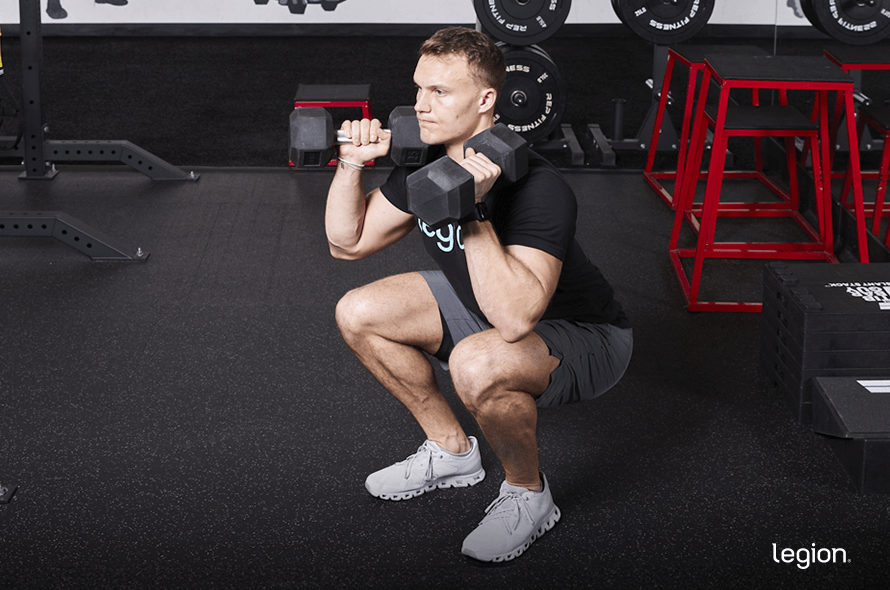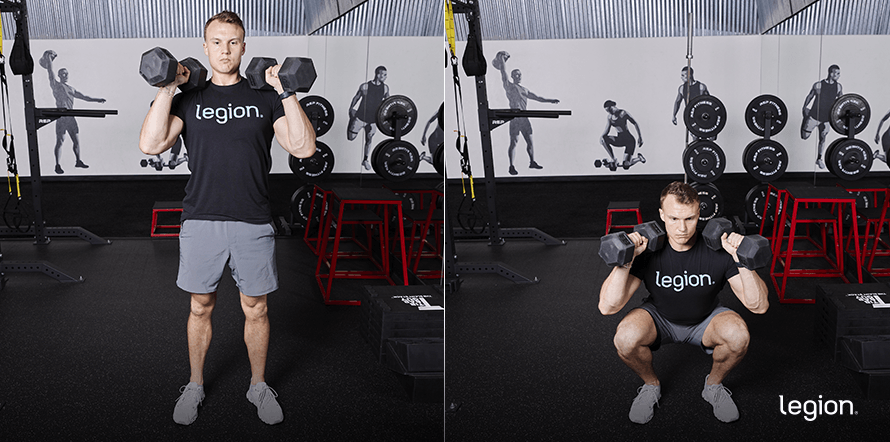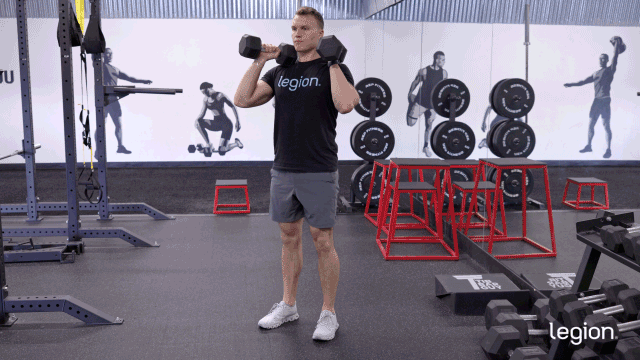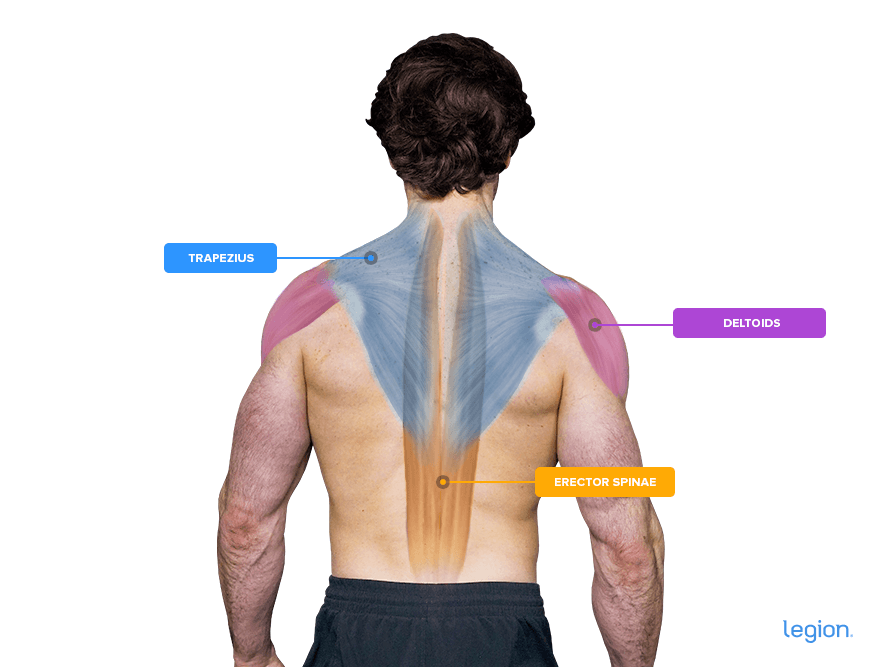The dumbbell front squat is hard to beat for its simplicity and effectiveness.
With just a pair of dumbbells and a bit of floor space, you can build muscle and strength throughout your entire lower body while also training major upper body muscles, including your back, shoulders, and core.
Even better, it’s gentler on your joints than barbell squatting and easy to learn, making it an ideal exercise for beginners venturing into free-weight training.
That said, mastering the dumbbell front squat requires a few specific form pointers, particularly when setting up the exercise.
In this article, you’ll learn everything you need to perform front squats with dumbbells safely and effectively, from setup to execution, along with the benefits, muscles worked, and more.
Key Takeaways
- The dumbbell front squat is a simple, effective lower body exercise that requires only a pair of dumbbells and minimal floor space.
- It builds strength in your entire lower body while also engaging major upper body muscles like your core, shoulders, and back.
- It’s gentler on your joints than barbell squats, so it’s ideal for beginners, offering a safe yet effective way to develop leg muscle and strength.
- Proper form, especially during the setup, is essential for safely reaping all the benefits of the dumbbell front squat.
- The best variations of the dumbbell front squat are the dumbbell squat, dumbbell front squat to press, box front squat with dumbbells, goblet squat, and dumbbell sumo squat.

Table of Contents
+
How to Do Dumbbell Front Squats
The easiest way to learn how to do dumbbell front squats is to split the exercise into three parts: set up, descend, and squat.

1. Set up
The trickiest part of performing front squats with dumbbells on your shoulders is moving the weights from your sides to shoulder height—a position known as the “dumbbell front rack”. You’ve got two ways to do it:
- Curl the weights: If the dumbbells are light, perform a hammer curl to bring them to shoulder height.
- Clean the weights: When the dumbbells get too heavy to curl, perform a “clean”—an explosive movement that uses lower-body momentum to bring the weights up to your shoulders.
To clean the weights to shoulder height, stand with a hip-width stance holding a dumbbell in each hand and your palms facing your thighs. Take a deep breath and brace your core like you’re about to take a punch, then slightly bend at your hips and knees as if you’re about to jump.
While keeping your back straight and eyes forward, explode upward by driving through your heels, using the momentum to pull the dumbbells up toward your shoulders. Think of it as your legs giving a quick “pop” to send the weight upward.
As the dumbbells reach shoulder height, position them so the ends nearest your thumbs rest on your shoulders, then push your elbows up and out in front of you to complete the front rack.
2. Descend
While maintaining the dumbbell front rack position, sit straight down, pushing your knees out in the same direction as your toes.
Descend until your hip creases (the points where your thighs meets your pelvis) is one-to-two inches below the tops of your knees.
3. Squat
Stand up and return to the starting position. Here’s how it should look when you put it all together:

Dumbbell Front Squat Benefits
Builds Lower Body Muscle
The dumbbell front squat trains your entire lower body, including your quads, glutes, and hamstrings. It also engages your core, shoulders, and lower and mid back to help stabilize the weight.
In other words, it’s an excellent exercise for building lower body muscle that also trains several other major muscle groups throughout the body.
RELATED: This Is the Last Lower Body Workout You’ll Ever Need
Gentle on Your Knees and Lower Back
Research shows that front-loaded squats, like the dumbbell front squat, place significantly less compressive force on your knees and lower back compared to back squats. This makes it a smart choice for anyone with knee or back issues who still wants to build lower body muscle and strength.
RELATED: Should Your Knees Go Over Your Toes When You Squat?
Suitable for New Weightlifters
Performing the front squat with dumbbells requires less technique than squatting with a barbell, making it an ideal starting point for anyone new to weightlifting. It also requires minimal equipment, so it’s a great option for anyone starting their fitness journey who prefers to train at home.
RELATED: The Complete Beginner’s Guide to Weightlifting
Muscles Worked by Dumbbell Front Squats
The main muscles worked by dumbbell front squats are:
- Quadriceps (quads)
- Glutes
- Hamstrings
- Erector spinae (lower back)
- Traps
- Deltoids (delts)
- Core
Here’s how these muscles look on your body:


Dumbbell Front Squat Variations
1. Dumbbell Squat
The dumbbell squat is similar to the front squat but doesn’t train your upper body muscles—like your mid back and shoulders—as effectively. Holding the dumbbells at your sides also puts more strain on your grip and can feel awkward, especially with bulkier or heavier dumbbells.
That’s why I typically prefer the dumbbell front squat, especially when the weights get heavy.
READ MORE: Dumbbell Squat: Variations, Form & Benefits
2. Dumbbell Front Squat to Press
While the dumbbell front squat to press is an excellent full-body conditioning exercise, it’s not as good as the regular dumbbell front squat for building lower body muscle. That’s because you’re limited to the amount of weight your shoulders can press, which typically isn’t heavy enough to tax your legs.
3. Box Front Squat with Dumbbells
In the box front squat with dumbbells, you sit back onto a box at the bottom of each rep, which keeps your shins more vertical and reduces knee stress. This makes it an excellent option if you’re dealing with knee pain or looking for a more controlled way to train your legs without compromising joint health.
4. Dumbbell Goblet Squat
There is just one major difference between the goblet squat and the dumbbell front squat: in the goblet squat you hold a single dumbbell in front of your chest instead of resting dumbbells on your shoulders.
While this makes the goblet squat easier to set up, it also makes it more demanding on your upper back, which may limit how much weight you can lift and, thus, how much lower body muscle you build.
For this reason, the goblet squat is a good variation to use as an introduction to free-weight squatting, but eventually, the dumbbell front squat will be better for gaining leg muscle and strength.
READ MORE: Goblet Squat: Form, Form, Muscles Worked, & Common Mistakes
5. Dumbbell Sumo Squat
The dumbbell sumo squat uses a wide stance with your feet turned out, which increases glute activation and allows you to squat deeper, both of which can help you build your glutes. It also emphasizes your adductor longus, giving it an edge over regular dumbbell front squats if inner thigh development is a priority.
READ MORE: How to Do a Sumo Squat: Form, Benefits, and Variations
FAQ #1: Are dumbbell front squats effective?
Yes, squatting with dumbbells in front of you is highly effective for building lower body strength and muscle. It primarily trains your quads, glutes, and hamstrings, but also engages your core and back to stabilize the weight.
Put simply, it’s a fantastic exercise for training your lower body that also helps develop several major upper body muscle groups.
FAQ #2: How much weight should I use for dumbbell front squats?
Performing dumbbell front squats in the 8-to-10 rep range works best for most people. That is, choose a weight light enough to hit at least 8 reps per set, but heavy enough that you can’t do more than 10.
Lifting in a lower rep range with heavier weights makes setting up the exercise awkward, while lighter weights and higher reps can push your cardiovascular limits before your muscles are fully stimulated. In other words, aim for a weight that lets your muscles—not your lungs—dictate when the set ends.
FAQ #3: Dumbbell front squat vs. Goblet squat: Which is better?
Both exercises are effective, but dumbbell front squats generally offer more long-term potential for building lower body muscle and strength. The goblet squat is often easier to set up and great for beginners, but it’s more challenging on your upper back, which can limit how much weight you can lift.
The dumbbell front squat allows you to handle more weight, making it the better option for progressing your lower body strength over time.
READ MORE: What Is Progressive Overload Training?
Scientific References +
- BAUTISTA, DAVID, et al. “A Comparison of Muscle Activation among the Front Squat, Overhead Squat, Back Extension and Plank.” International Journal of Exercise Science, vol. 13, no. 1, May 2020, p. 714, pmc.ncbi.nlm.nih.gov/articles/PMC7241624/.
- Gullett, Jonathan C, et al. “A Biomechanical Comparison of Back and Front Squats in Healthy Trained Individuals.” Journal of Strength and Conditioning Research, vol. 23, no. 1, Jan. 2009, pp. 284–292, journals.lww.com/nsca-jscr/fulltext/2009/01000/A_Biomechanical_Comparison_of_Back_and_Front.41.aspx, https://doi.org/10.1519/jsc.0b013e31818546bb.
- Swinton, Paul A., et al. “A Biomechanical Comparison of the Traditional Squat, Powerlifting Squat, and Box Squat.” Journal of Strength and Conditioning Research, vol. 26, no. 7, July 2012, pp. 1805–1816, https://doi.org/10.1519/jsc.0b013e3182577067.
- Fry, Andrew C., et al. “Effect of Knee Position on Hip and Knee Torques during the Barbell Squat.” The Journal of Strength & Conditioning Research, vol. 17, no. 4, 1 Nov. 2003, pp. 629–633, journals.lww.com/nsca-jscr/Abstract/2003/11000/Effect_of_Knee_Position_on_Hip_and_Knee_Torques.1.aspx.
- McBride, Jeffrey M, et al. “Comparison of Kinetic Variables and Muscle Activity during a Squat vs. a Box Squat.” Journal of Strength and Conditioning Research, vol. 24, no. 12, Dec. 2010, pp. 3195–3199, https://doi.org/10.1519/jsc.0b013e3181f6399a.
- Paoli, Antonio, et al. “The Effect of Stance Width on the Electromyographical Activity of Eight Superficial Thigh Muscles during Back Squat with Different Bar Loads.” Journal of Strength and Conditioning Research, vol. 23, no. 1, Jan. 2009, pp. 246–250, https://doi.org/10.1519/jsc.0b013e3181876811.
- Larsen, Stian , et al. Effects of Stance Width and Barbell Placement on Kinematics, Kinetics, and Myoelectric Activity in Back Squats. 31 Aug. 2021, www.frontiersin.org/journals/sports-and-active-living/articles/10.3389/fspor.2021.719013/full, https://doi.org/10.3389/fspor.2021.719013.
- Lorenzetti, Silvio, et al. “How to Squat? Effects of Various Stance Widths, Foot Placement Angles and Level of Experience on Knee, Hip and Trunk Motion and Loading.” BMC Sports Science, Medicine and Rehabilitation, vol. 10, no. 1, 17 July 2018, bmcsportsscimedrehabil.biomedcentral.com/articles/10.1186/s13102-018-0103-7, https://doi.org/10.1186/s13102-018-0103-7.
- Kubo, Keitaro, et al. “Effects of Squat Training with Different Depths on Lower Limb Muscle Volumes.” European Journal of Applied Physiology, vol. 119, no. 9, 22 June 2019, https://doi.org/10.1007/s00421-019-04181-y.
- Marchetti, Paulo Henrique, et al. “Muscle Activation Differs between Three Different Knee Joint-Angle Positions during a Maximal Isometric Back Squat Exercise.” Journal of Sports Medicine, vol. 2016, 2016, pp. 1–6, www.ncbi.nlm.nih.gov/pmc/articles/PMC4967668/, https://doi.org/10.1155/2016/3846123. Accessed 9 Dec. 2019.
- Delmore, Robert J., et al. “Adductor Longus Activation during Common Hip Exercises.” Journal of Sport Rehabilitation, vol. 23, no. 2, May 2014, pp. 79–87, https://doi.org/10.1123/jsr.2012-0046.










